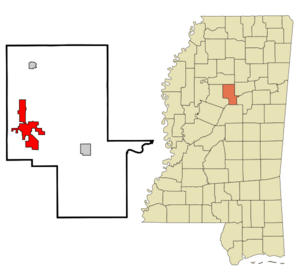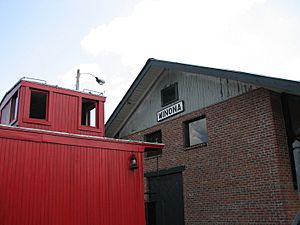Winona, Mississippi facts for kids
Quick facts for kids
Winona, Mississippi
|
|||
|---|---|---|---|
 |
|||
|
|||
| Nickname(s):
Art and Soul of Mississippi
|
|||

Location in Montgomery County and the state of Mississippi
|
|||
| Country | United States | ||
| State | Mississippi | ||
| County | Montgomery | ||
| Government | |||
| • Type | Mayor-council government | ||
| Area | |||
| • Total | 13.55 sq mi (35.09 km2) | ||
| • Land | 13.52 sq mi (35.01 km2) | ||
| • Water | 0.03 sq mi (0.08 km2) | ||
| Elevation | 381 ft (116 m) | ||
| Population
(2020)
|
|||
| • Total | 4,505 | ||
| • Density | 333.31/sq mi (128.69/km2) | ||
| Time zone | UTC−6 (Central (CST)) | ||
| • Summer (DST) | UTC−5 (CDT) | ||
| ZIP code |
38967
|
||
| Area code(s) | 662 | ||
| FIPS code | 28-80760 | ||
| GNIS feature ID | 0679787 | ||
Winona is a city in Montgomery County, Mississippi, United States. It is also the county seat, which means it's where the county government is located. In 2020, about 4,500 people lived here.
Winona is often called "The Crossroads" because important highways meet here. These include Interstate 55, U.S. Highway 51, and U.S. Route 82.
Contents
Discovering Winona's Past
How Winona Began: The Story of Middleton
Before Winona, there was a town called Middleton. It grew in the 1800s about two miles west of where Winona is now. Some people think Middleton was the first version of Winona. But when a new railroad was built to the east, people and businesses moved to the new area, and that became Winona.
The Founding of Winona
The first European-American settler in this area was Colonel O.J. Moore. He came from Virginia in 1848. The land was then part of Carroll County. Colonel Moore allowed the railroad to be built through his property. A train station was built near his home in 1860.
Because of the new railroad and station, Winona started to grow. Businesses opened around the station as Colonel Moore sold parts of his land. Winona officially became a town on May 2, 1861. The easy access to the railroad made Winona a busy trading center.
Captain William Witty, an early settler from North Carolina, was a major merchant in Winona for many years. He also started the first bank in the county. Other early families included Curtis, Burton, Palmer, Spivey, Townsend, Hart, Turner, and Campbell. Most of the first businesses were grocery stores.
In 1871, the state government created Montgomery County. Winona was chosen as its county seat. In 1878, a serious yellow fever sickness spread through the area. Many people died, and some left town to try and escape the illness.
In April 1888, a large fire destroyed almost all of Winona's business area. Forty out of 50 businesses burned down.
Winona in the 20th Century
After World War II, many African Americans in the South began working to gain their full rights. This movement grew stronger in the 1950s and 1960s.
In 1963, a famous activist named Fannie Lou Hamer and others were traveling through Winona. They were on their way to a workshop. On their return trip, they stopped in Winona again. They were arrested and put in jail. While in jail, they were treated very badly.
During this time, Rev. Martin Luther King Jr., a leader of the Southern Christian Leadership Conference (SCLC), visited Winona. He was protected by a local police officer named Garrit Howard.
In 2020, a long legal case involving a local furniture store owner and employees was finally closed.
The 2023 Tornado
On Friday, March 24, 2023, a powerful tornado hit the southern part of Winona. It caused a lot of damage and sadly, three people lost their lives.
Winona's Location and Climate
Where is Winona?
Winona is in the western part of Montgomery County. It's about 92 miles north of Jackson, which is Mississippi's capital city. It's also about 23 miles south of Grenada.
Interstate 55 runs through the western edge of the city. U.S. Route 51 goes through the west side of Winona. U.S. Route 82 has a four-lane bypass on the north side of the city. These roads connect Winona to other towns like Duck Hill, Vaiden, Starkville, and Greenwood.
Winona covers about 13.6 square miles of land. A very small part, about 0.03 square miles, is water. The city is mostly on the west side of the valley of Hays Creek. This creek flows south into the Big Black River.
Winona's Weather
Winona has a warm climate. Summers are hot, and winters are mild. It gets a good amount of rain throughout the year. Snowfall is very rare.
| Climate data for Winona, Mississippi (1991–2020 normals, extremes 1953–present) | |||||||||||||
|---|---|---|---|---|---|---|---|---|---|---|---|---|---|
| Month | Jan | Feb | Mar | Apr | May | Jun | Jul | Aug | Sep | Oct | Nov | Dec | Year |
| Record high °F (°C) | 82 (28) |
84 (29) |
87 (31) |
92 (33) |
86 (30) |
101 (38) |
104 (40) |
105 (41) |
104 (40) |
97 (36) |
88 (31) |
82 (28) |
105 (41) |
| Mean daily maximum °F (°C) | 52.6 (11.4) |
57.1 (13.9) |
65.3 (18.5) |
72.7 (22.6) |
79.9 (26.6) |
86.7 (30.4) |
89.3 (31.8) |
89.6 (32.0) |
85.3 (29.6) |
75.2 (24.0) |
63.7 (17.6) |
55.3 (12.9) |
72.7 (22.6) |
| Daily mean °F (°C) | 40.9 (4.9) |
44.5 (6.9) |
51.9 (11.1) |
59.4 (15.2) |
67.7 (19.8) |
75.3 (24.1) |
78.3 (25.7) |
77.8 (25.4) |
72.4 (22.4) |
61.2 (16.2) |
50.1 (10.1) |
43.6 (6.4) |
60.3 (15.7) |
| Mean daily minimum °F (°C) | 29.2 (−1.6) |
31.8 (−0.1) |
38.6 (3.7) |
46.0 (7.8) |
55.6 (13.1) |
63.9 (17.7) |
67.2 (19.6) |
66.0 (18.9) |
59.5 (15.3) |
47.2 (8.4) |
36.5 (2.5) |
31.8 (−0.1) |
47.8 (8.8) |
| Record low °F (°C) | −9 (−23) |
0 (−18) |
9 (−13) |
24 (−4) |
34 (1) |
40 (4) |
49 (9) |
50 (10) |
34 (1) |
25 (−4) |
14 (−10) |
−2 (−19) |
−9 (−23) |
| Average precipitation inches (mm) | 5.38 (137) |
5.45 (138) |
5.64 (143) |
6.12 (155) |
4.98 (126) |
4.49 (114) |
5.33 (135) |
4.07 (103) |
3.95 (100) |
3.74 (95) |
4.16 (106) |
5.72 (145) |
59.03 (1,497) |
| Average snowfall inches (cm) | 0.2 (0.51) |
0.4 (1.0) |
0.2 (0.51) |
0.0 (0.0) |
0.0 (0.0) |
0.0 (0.0) |
0.0 (0.0) |
0.0 (0.0) |
0.0 (0.0) |
0.0 (0.0) |
0.0 (0.0) |
0.0 (0.0) |
0.8 (2.02) |
| Average precipitation days (≥ 0.01 in) | 10.5 | 10.1 | 11.1 | 9.3 | 9.5 | 9.2 | 10.4 | 9.2 | 6.8 | 6.5 | 8.3 | 9.9 | 110.8 |
| Average snowy days (≥ 0.1 in) | 0.3 | 0.2 | 0.1 | 0.0 | 0.0 | 0.0 | 0.0 | 0.0 | 0.0 | 0.0 | 0.0 | 0.1 | 0.7 |
| Source: NOAA | |||||||||||||
People of Winona
Population Changes Over Time
Winona's population has changed over the years. In 1880, about 1,200 people lived here. The population grew steadily, reaching its highest point in 1980 with over 6,000 residents. Since then, the population has slowly decreased to about 4,500 people in 2020.
| Historical population | |||
|---|---|---|---|
| Census | Pop. | %± | |
| 1880 | 1,204 | — | |
| 1890 | 1,648 | 36.9% | |
| 1900 | 2,455 | 49.0% | |
| 1910 | 2,512 | 2.3% | |
| 1920 | 2,572 | 2.4% | |
| 1930 | 2,607 | 1.4% | |
| 1940 | 2,532 | −2.9% | |
| 1950 | 3,441 | 35.9% | |
| 1960 | 4,282 | 24.4% | |
| 1970 | 5,521 | 28.9% | |
| 1980 | 6,177 | 11.9% | |
| 1990 | 5,705 | −7.6% | |
| 2000 | 5,482 | −3.9% | |
| 2010 | 5,043 | −8.0% | |
| 2020 | 4,505 | −10.7% | |
| U.S. Decennial Census | |||
Who Lives in Winona?
Based on the 2020 census, Winona is a diverse city.
- About 42% of residents are White.
- About 54% are Black or African American.
- A smaller number of residents are Asian, or identify as other races or mixed races.
- Less than 1% of the population is Hispanic or Latino.
| Race | Num. | Perc. |
|---|---|---|
| White (non-Hispanic) | 1,890 | 41.95% |
| Black or African American (non-Hispanic) | 2,439 | 54.14% |
| Asian | 15 | 0.33% |
| Other/Mixed | 121 | 2.69% |
| Hispanic or Latino | 40 | 0.89% |
In 2020, there were 4,505 people living in Winona. There were 1,696 households and 1,223 families.
Winona's Economy and Education
Local Businesses and Jobs
In 2005, a company called Pilot Travel Centers bought a large truck stop in Winona. This helped the local economy.
In 2021, Biewer Lumber announced plans to build a new sawmill in Winona. This project is a big investment and is expected to create over 150 new jobs for the area.
Schools in Winona
Winona has both public and private schools.
Public Schools
- Winona- Montgomery County Consolidated School District
- Winona Vocational Complex
Private Schools
- Winona Christian Academy
Media and Famous People
Local News and Radio
Winona has its own newspaper and radio stations.
Newspapers
- The Winona Times (published since 1881)
- The Winona Advance (published from 1869 to 1890)
Radio Stations
| Frequency | Callsign | Format | Owner |
|---|---|---|---|
| 95.1 FM | WONA-FM | Country | Southern Electronics Co., Inc. |
| 1570 | WLEE-AM | Country | Back Forty Broadcasting, LLC |
Notable People from Winona
Many interesting people have connections to Winona. They include athletes, musicians, writers, and people who have worked in government or other important fields.
- Waldo Emerson Bailey, former U.S. consul
- William Billingsley, naval pilot
- Lydia Chassaniol, member of the Mississippi Senate
- Pearl Conklin, composer
- Little Sammy Davis, blues musician
- Jane Holmes Dixon, Episcopal bishop
- D'Wayne Eskridge, NFL wide receiver
- Chris Faser Jr., former politician
- Henry Minor Faser, life insurance executive and founding dean of the University of Mississippi School of Pharmacy
- Curtis Flowers, involved in a legal case
- Wade Griffin, NFL football player
- George P. Gunn, fifth Episcopal Bishop of Southern Virginia
- E. W. Hammons, film producer
- Bill Harvey, rhythm and blues saxophonist and bandleader
- Frank W. Hunger, former U.S. Assistant Attorney General
- Lafayette Leake, blues and jazz pianist
- L. C. McKinley, Chicago blues guitarist
- Henry Milton, Negro league outfielder
- Howard Mitcham, poet, author, chef
- Chip Oliver, former NFL linebacker
- Karl Oliver, member of the Mississippi House of Representatives
- Donald H. Peterson, astronaut
- Gil Peterson, actor
- Sid Robinson, middle-distance runner who competed in the men's 1500 metres at the 1928 Summer Olympics.
- Thomas U. Sisson, member of the U.S. House of Representatives from 1909 to 1923
- William Small, college basketball coach
- Roebuck Staples, gospel and R&B musician
- William V. Sullivan, U.S. senator
- John Tapley, Negro league third baseman
- John Peroutt Taylor, State Treasurer of Mississippi from 1916 to 1920
- James Michael Tyler, actor
- Chris White, NFL football player
See also
 In Spanish: Winona (Misisipi) para niños
In Spanish: Winona (Misisipi) para niños





